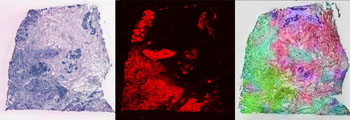Spatial Transcriptomics Technique Enables Visualization of Gene Expression in Tissues
By LabMedica International staff writers
Posted on 12 Jul 2016
A team of Swedish researchers has developed a high-resolution method for resolving the transcriptome – the library of active genes and RNAs – in histological samples of patients' tissues.Posted on 12 Jul 2016
Analysis of the pattern of proteins or messenger RNAs (mRNAs) in histological tissue sections is a vital aspect of biomedical research and diagnostics. Due to the complexities of current techniques, this typically involves the visualization of only a few proteins or expressed genes at a time.

Image: Researchers have devised a new high-resolution method for studying which genes are active in a tissue. The method can be used on all types of tissue and is valuable to both preclinical research and cancer diagnostics (Photo courtesy of the Karolinska Institutet / the Royal Institute of Technology).
Investigators at the Karolinska Institutet (Stockholm, Sweden) and the Royal Institute of Technology (Stockholm, Sweden) described a method for visualization and quantitative analysis of the complete transcriptome with spatial resolution in individual tissue sections.
The method, which they called "spatial transcriptomics", relied on positioning histological sections onto arrayed reverse transcription primers with unique positional barcodes. Reverse transcription was followed by sequencing and computational reconstruction, and this could be done for multiple genes simultaneously. By positioning histological sections on arrayed reverse transcription primers with unique positional barcodes, the investigators demonstrated high-quality RNA-sequencing data with maintained two-dimensional positional information from mouse brain and human breast cancer.
"By placing tissue sections on a glass slide on which we have placed DNA strands with built in address labels we have been able to label the RNA molecules formed by active genes," said senior author Dr. Jonas Frisén, professor of stem cell research at the Karolinska Institutet. "When we analyze the presence of RNA molecules in the sample, the address labels show where in the section the molecules were and we can get high-resolution information on where different genes are active. It makes it possible to study which genes are active in tissues with greater resolution and precision than ever before, which is valuable to both basic research and diagnostics."
The method was described in detail in a paper published in the July 1, 2016, issue of the journal Science.
Related Links:
Karolinska Institutet
Royal Institute of Technology














